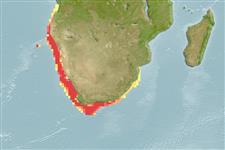Environment: milieu / climate zone / depth range / distribution range
Écologie
marin bathydémersal; océanodrome (Ref. 51243); profondeur 50 - 1000 m (Ref. 27121), usually 150 - 450 m (Ref. 27121). Deep-water; 11°S - 37°S, 5°E - 33°E (Ref. 58452)
Southeast Atlantic: Baie Farte, Angola around Cape to Natal, South Africa. Also found on Valdivia Bank (26°18'S, 6°20'E).
Length at first maturity / Taille / Poids / Âge
Maturity: Lm 47.4 range ? - ? cm
Max length : 140 cm TL mâle / non sexé; (Ref. 6605); common length : 50.0 cm TL mâle / non sexé; (Ref. 1371)
Épines dorsales (Total) : 1; Rayons mous dorsaux (Total) : 47 - 54; Épines anales: 0; Rayons mous anaux: 37 - 41. Light brown above, silvery to white below (Ref. 6605).
Found on the continental shelf and slope to depths over 1,000 m (Ref. 27121). Juveniles (to about 64 cm) feed on small crustaceans and small deep-sea fishes such as lanternfishes, whereas larger individuals feed chiefly on small hakes and jack mackerel (Ref. 1371); cannibalism is common (Ref. 27121). Migrates southward in the spring and northward in autumn (Ref. 1371). Breeds throughout the year, peaks of reproductive activity in August and September (Ref. 36731). Marketed smoked, frozen, and fresh on ice; eaten steamed, fried and baked (Ref. 9988).
Life cycle and mating behavior
Maturité | Reproduction | Frai | Œufs | Fécondité | Larves
Cohen, D.M., T. Inada, T. Iwamoto and N. Scialabba, 1990. FAO species catalogue. Vol. 10. Gadiform fishes of the world (Order Gadiformes). An annotated and illustrated catalogue of cods, hakes, grenadiers and other gadiform fishes known to date. FAO Fish. Synop. 125(10). Rome: FAO. 442 p. (Ref. 1371)
Statut dans la liste rouge de l'IUCN (Ref. 130435: Version 2024-1)
Menace pour l'homme
Harmless
Utilisations par l'homme
Pêcheries: intérêt commercial mineur
Outils
Articles particuliers
Télécharger en XML
Sources Internet
Estimates based on models
Preferred temperature (Ref.
123201): 7.7 - 14.4, mean 10.2 °C (based on 78 cells).
Phylogenetic diversity index (Ref.
82804): PD
50 = 0.5000 [Uniqueness, from 0.5 = low to 2.0 = high].
Bayesian length-weight: a=0.00513 (0.00339 - 0.00775), b=3.11 (2.98 - 3.24), in cm total length, based on LWR estimates for this species & Genus-body shape (Ref.
93245).
Niveau trophique (Ref.
69278): 3.9 ±0.65 se; based on food items.
Generation time: 9.2 (7.9 - 12.1) years. Estimated as median ln(3)/K based on 21
growth studies.
Résilience (Ref.
120179): Faible, temps minimum de doublement de population : 4,5 à 14 années (K=0.07-0.13).
Fishing Vulnerability (Ref.
59153): High to very high vulnerability (67 of 100).
Climate Vulnerability (Ref.
125649): Very high vulnerability (86 of 100).
Nutrients (Ref.
124155): Calcium = 6.55 [3.45, 22.85] mg/100g; Iron = 0.282 [0.055, 0.771] mg/100g; Protein = 16.8 [15.7, 18.1] %; Omega3 = 0.123 [0.066, 0.231] g/100g; Selenium = 32.1 [14.4, 77.4] μg/100g; VitaminA = 9.09 [1.90, 42.59] μg/100g; Zinc = 0.225 [0.151, 0.358] mg/100g (wet weight);
